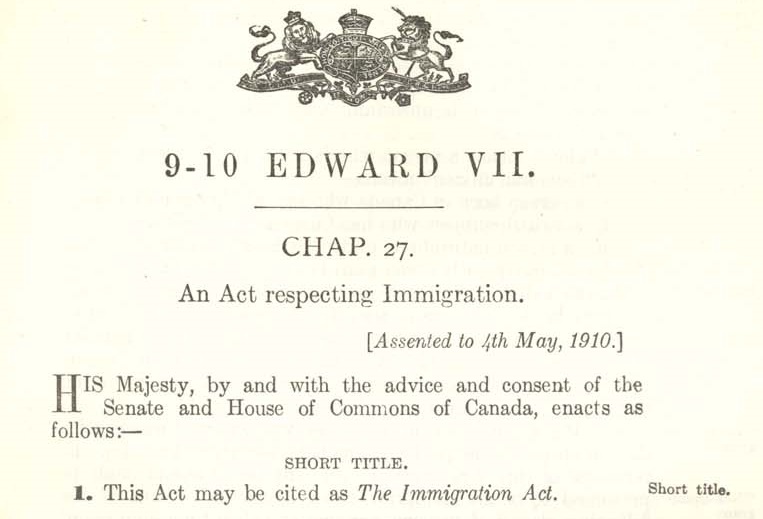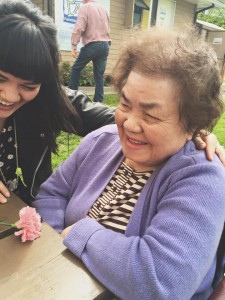In this lesson I say that it should be clear that the discourse on nationalism is also about ethnicity and ideologies of “race.” If you trace the historical overview of nationalism in Canada in the CanLit guide, you will find many examples of state legislation and policies that excluded and discriminated against certain peoples based on ideas about racial inferiority and capacities to assimilate. – and in turn, state legislation and policies that worked to try to rectify early policies of exclusion and racial discrimination. As the guide points out, the nation is an imagined community, whereas the state is a “governed group of people.” For this blog assignment, I would like you to research and summarize one of the state or governing activities, such as The Royal Proclamation 1763, the Indian Act 1876, Immigration Act 1910, or the Multiculturalism Act 1989 – you choose the legislation or policy or commission you find most interesting. Write a blog about your findings and in your conclusion comment on whether or not your findings support Coleman’s argument about the project of white civility.
The Immigration Act of 1910 is a restrictive immigration legislation that gave the Government of Canada a great deal of power when dealing with Canadian Immigrants. The Act places significant restrictions on a number of citizens, creating artificial boundaries for who is and is not considered worthy of entry into Canada. The Act creates terms for non-citizens, calling them “aliens,” a term we hear often in reference to what some consider Illegal Immigrants (a term many people, including myself, are not comfortable with. See: no one is illegal).
The Act says that an “‘alien’ means a person who is not a British subject”. It goes on to explain the “definition” of a Canadian citizen.
Canadian Citizen means:
- A person born in Canada who has not become an alien
- A British subject who has Canadian domicile; or
- A person naturalized under the laws of Canada who has not subsequently become an alien or lost Canadian domicile
The Act specifies “prohibited classes,” including, “idiots, imbeciles, feeble-minded persons, epileptics, insane persons, and persons believed to be insane within five previous years,” or otherwise people who are “mentally defective” (4). It also specifies that people with diseases, those who are “dumb, blind, or otherwise physically defective,” prostitutes, beggars, and “charity immigrants,” meaning those who are able to land in Canada through money donated by a charitable organization, are also prohibited from immigrating (2). As Kevin and Charmaine explain, Immigrants from Asiatic countries, particularly Chinese Immigrants, were governed under even stricter rules than the Act entails, building larger boundaries around who can enter the country.
This Act also states that “the Governer Council may, at any time, order any such persons found by a Board of Inquiry or examining officer to belong to any of the undesirable classes… to leave Canada within a specified period” (16). This is unfortunately not an obsolete law; on April 1st, 2015, Canada saw massive deportations of low-waged migrant workers in the Temporary Foreign Worker Program (TFWP) and the Live-In Caregiver Program (LCP).
The Immigration Act allows the Government of Canada to practice complete control over any person entering the country. Instead of treating people like humans, they are treated as second class citizens, arbitrarily classified by an outdated system.
The jargon used in the Immigration Act on its own is incredibly exclusionary and demonstrates Coleman’s argument about the project of white civility. Coleman says that “beginning with colonials and early nation-builders, there has been a ‘literary endeavor’ to ‘formulate and elaborate a specific form of [Canadian] whiteness based on the British model of civility” (Coleman in Patterson). He goes on to say that we see this “white civility” in “regularly repeated literary personifications for the Canadian Nation” which have “mediated and gradually reified the privileged, normative status of British Whiteness in English Canada”.
This “fictive ethnicity” that Coleman refers to is constantly referenced in the Immigration Act, starting with the definition of an “alien” as someone who is not a British subject. This of course gives Canada a white, civil identity. Instead of honouring the First Nations of Canada, the history is erased and replaced with an image of, as Coleman states, white civility.
The Act also states that a person is a Canadian citizen if they are “naturalized under the laws of Canada.” The CanLit guide tells us that “a nation is a group of people who regard themselves as sharing the same culture.” What the Act is saying then is that in order to become a part of the Canadian nation, one must assimilate with the constructed culture of Canada — that is, a culture of white civility.
As Coleman states, “Canadians need to be reminded of the brutal histories that our fictive ethnicity would disavow” (9). Legislation like the Immigration Act is a tacit demonstration of the Canadian government’s attempt to rewrite its history of violent colonialism. However, as we know, colonialism still continues today. It isn’t history yet.
Works Cited:
CanLit Guides. “Reading and Writing in Canada, A Classroom Guide to Nationalism.” Canadian Literature. Web. April 4th 2013.
“Immigration Act of 1910.”Pier21.ca, Canadian Museum of Immigration at Pier21, N.d. Web. 26 June 2015.
Li, Charmaine. “Race, Nationalism, and a Forgotten Story” Canadian Yarns and Storytelling Threads. 26 June 2015. Web. 26 June 2015.
“No One Is Illegal – Vancouver.” No One Is Illegal Vancouver RSS., N.d. Web. 26 June 2015.
Paterson, Erika. “Lesson 3:1.” ENGL 470A Canadian Studies Canadian Literary Genres. University of British Columbia Blogs, 2015. Web. 26 June 2015.
Sun, Kevin. “Politely Taxing the Chinese?” Many Homes, One Earth. 26 June 2015. Web. 26 June 2015.
Syed, Fatima. “Temporary foreign workers face deportation come April 1.” Rabble.ca, 18 Mar. 2015. Web. 26 June 2015.


